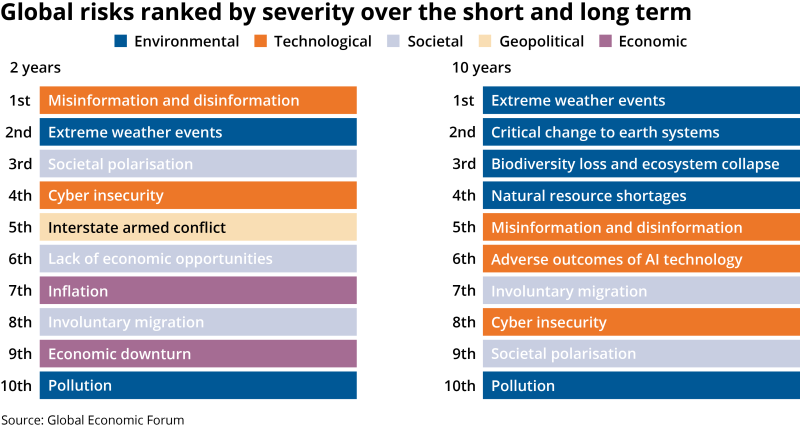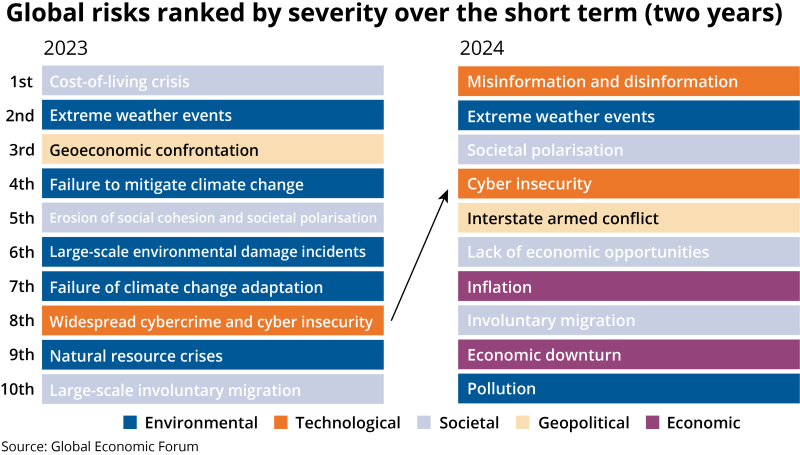The themes that it earmarks put several key insurance segments, from catastrophe risk to cyber to political violence business, squarely in the hotspot of emerging risks.
However, counter-intuitively, some of these segments are also ones where insurance competition remains vibrant despite these persistent risk levels, as insurers signal they believe rates are on top of these risks.
The Global Risks report, produced in collaboration with Marsh and Zurich, ranks a myriad of both established and emerging risks by severity according to a survey of more than 1,000 experts.
It also looks at changes in the perception of short-term global risks over the years, with some shooting up the list, such as concentration of power among global tech players, and other recent concerns, such as unemployment falling fast.
But while emerging risks often get market-watchers agitated, the risks identified as the most persistent should also give pause for thought.
The report found that four risks – extreme weather, societal polarisation, cyber insecurity and involuntary migration – are ranked within the index year after year. All four of these are also within the top 10 of the 34 risks for 2024.

Climate still a top concern
As could be expected, extreme weather – now overwhelmingly believed to be on the rise due to climate change – ranks highly in this year’s index, landing in second place over a two-year time horizon and first place over a 10-year outlook.
Despite the longevity of concern around extreme weather, and growing awareness outside of the insurance industry of the frequency of hurricanes, severe storms and droughts, the market at this stage appears to be displaying a level of reasonable comfort with the risk.
As noted in our renewals coverage, reinsurers taking the most volatile risks have signalled through a near-flat renewal that they are happy to continue writing the business, after having made meaningful adjustments to pricing and structures in cat business through 2023. Indeed, they even faced increased competition to participate in cat programmes for 2024.
Much of this increased comfort with cat risk, however, is not about price but about the “upstreaming” phenomenon seen over the past 18 months.
As previously reported, the almost-global move to lift attachment points on cat programmes – sometimes doubling retentions – has shifted a far greater amount of frequency cat risk from reinsurers to cedants.
The issue of how to provide economic resilience from extreme weather, outside of government intervention, now lies squarely on the shoulders of primary insurers – and pricing is still climbing as they grapple with that problem, albeit more slowly than in recent years.

Societal polarisation and involuntary migration
Societal polarisation and migration were identified as the third and eighth most concerning risks this year, both shifting up two places from last year, and have recurred through multiple years of research.
Societal polarisation is caused by ideological or cultural divisions within communities, reducing social stability, gridlocking decision-making and disrupting economies.
Involuntary migration, meanwhile, could be caused by persecution, a lack of economic opportunities, man-made and natural disasters or conflict.
The natural fit for this area of risk is the political violence (PV)/political risk market and indeed, multiple of the top risks earmarked in the report impact the PV segment in some way.
In contrast to other insurance lines discussed here, in this area there are more pressing signs of this turbulence still working their way through the market, with insurers and reinsurers cutting exposures and hiking rates.
As previously reported, at this renewal the political violence market faced continued uncertainty as well as ongoing mismatches in underlying and reinsurance coverages – though some gaps closed as insurers made more use of quota share coverages.
Over the past year, reinsurers have continued to push for tighter terms following the Parisian riots and the outbreak of hostilities between Israel and Hamas. A run of sensitive elections in 2024 is also making the market nervous.
With continually more expensive and scarce reinsurance and worsening loss trends, there is even an expectation that some smaller carriers may pull out of PV as the business becomes unprofitable.
Cyber and tech risks on the rise
Cyber- and technology-related risks were among those rising most in prominence over the past year, comparing the 2023 installment to this year’s assessment.
Cyber insecurity ranked fourth on this year’s near-term risks, up from eighth in last year’s report. However, in echoes of dynamics in the catastrophe market, (re)insurers are more relaxed on this front despite the high-risk perception, after years of corrective rate action.

Even if it is a growing risk zone, the cyber market is also a market of healthy competition, which has been driving underlying insurance rates down.
Indeed, sister title Insurance Insider US has described the existence of some “classic tell-tale signs of a coming acceleration of rate decline” – such as doubling of line sizes and desire to win market share.
A decision from insurers to hold more business net also underscores this confidence in their understanding of the risk, while the push to address and clarify cyber war exclusions also speaks to the concerns flagged in the WEF report.
Most promisingly, the cyber retro market has also made significant, if tentative, steps over the past year, with the emergence of multiple cyber cat bonds. This development in itself should boost confidence, as it alleviates the aggregation of risk that is a key fear around cyber, and distributes costs onto a wider capital base.
On the broader technology front, given how much attention the launch of ChatGPT drew in the past year, it is perhaps no surprise that a new risk such as misinformation and disinformation shot to the top of the near-term risk ranking.
The threat of falsified information or deep fakes also has implications for the social sphere and political risks. But it also links into the way that insurers are making use of sophisticated technology to assist development of the expanding automated underwriting space.
Insurers who are looking to co-opt this technology to assist with underwriting analysis may feel confident enough in their ability to filter out misinformation – but as we raised in our realist’s guide to the risk of using ChatGPT-style tools last year, they are not immune from these challenges. Even if tech-led insurers are restricting inputs to their AI tools, they could still face the risk of algorithms replicating biases that could be challenged, or hallucinating false responses.
Panellists at last year’s London Market Conference suggested the industry needed to design “guardrails” to make best use of AI technology.



